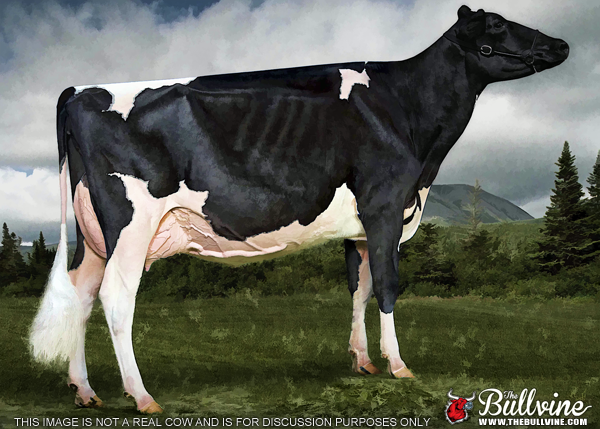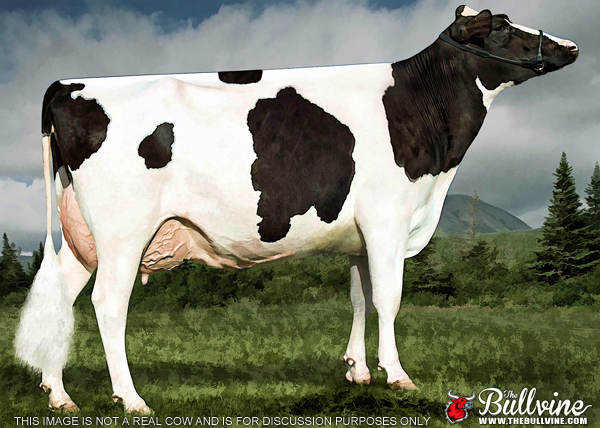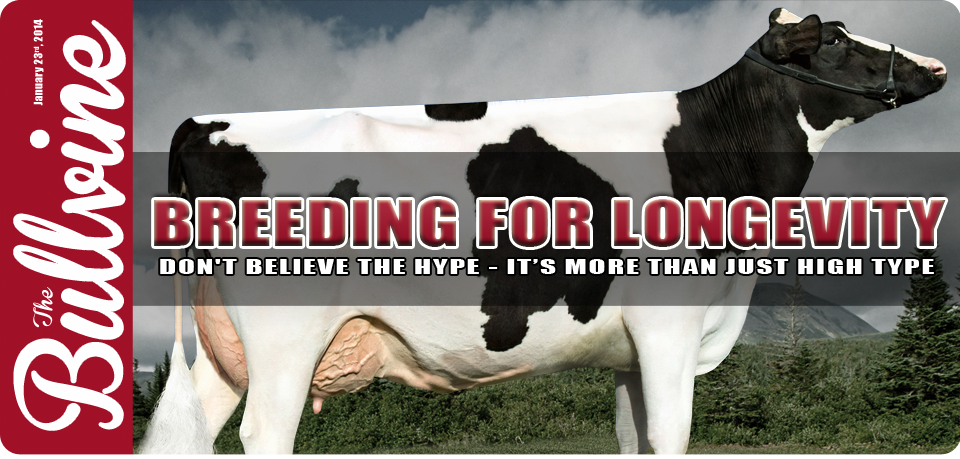Dairy cattle breeders want different results from their herds. Here at The Bullvine we highly recommend that breeders have a plan or strategy for how they select (Read more: What’s the plan?) and also cull. The cows we have today differ greatly from what existed even forty years ago. Holsteins have superior udders, Jerseys give more milk. One important factor that all breeders are attempting to turn around is early culling for both genetic and management reasons. With high rearing costs it is no long financially wise to raise a heifer only to cull her before she has paid for her rearing costs. It can be that the heifer is not truly profitable until she is milking in her third lactation. To order to provide breeders with some insight The Bullvine decided to do some investigation into Productive Life (PL).
Productive Life – What’s In It?
When a cow reaches twelve years of age, the facts are accurately known on her productivity over her lifetime. For an older proven bull, once his daughters reach their third lactation we have very good indication of how long lived his daughters will be. But in our fast paced breeding world we do not have actual results to rank heifers, young sires or even bulls with only early first crop proofs on their genetic ability to live long productive lives. What is done is that an animal’s genetic indexes for traits like SCS, reproduction, udders and feet & legs are used to estimate a PL index. The inclusion of genomic analysis in the calculation has resulted in the reliability for these indexes to increase to almost 60% from pre-genomics when they were less than 30%. Since so many factors, both genetic and non-genetic, affect longevity it will never be 100% accurate. However, on a population basis 60%, is a great stride forward.
What Bull Proofs Tell Us.
We found interesting results when we studied the top twenty-five PL daughter proven USA A.I. bulls from the December 2013 genetic index listings (USDA-CDCB and Holstein USA).
Table 1 – Averages for Top 25 Dec ’13 Daughter Proven A.I. Sires
These averages are different than we would have expected them to be. They are a much different group than the top 25 TPI™ or NM$ proven sires. They stand out by siring daughters that, on average, stay in the herd 6.7 months longer than the norm. That’s 2/3 of a lactation longer. They are positive but not high for milk, fat and protein. It was nice to see that they excel for SCS and DPR. (Read more: FACT VS. FANTASY: A Realistic Approach to Sire Selection)It is interesting to see that these bulls’ daughters have the ability to calve without difficulty. That makes sense – long lived cows avoid culling due to calving problems. What was most interesting was the fact that these sires did not produce daughters that were high for conformation. In fact they are only average for Body Composite (BC) and Dairy Composite (DC). That raises the question “Are our conformation evaluations standards right when it comes to body traits for the Ideal Cow? (Read more: The Perfect Holstein Cow): A closer look at body traits showed the following averages: Stature 0.35; Strength 0.19; and Body Depth 0.02. So the Holstein cows that remain in herds are not tall, strong or deep and from Dairy Composite we see that they are not even angular. Is that what commercial dairymen and breeders like Don Bennick are telling us? (Read more: NORTH FLORIDA HOLSTEINS. Aggressive, Progressive and Profitable!!) At any show ring you’ll hear ringside comments “she’s not tall enough, strong enough or dairy enough to win that class”. Maybe, just maybe, the judge was right when he won the class with the slightly shorter and not so wide cow that had a super udder and moved extremely well on the walk.

The Bullvine Holstein Model 2yr

The Bullvine Total Performance 2 Yr Old Cow
Further study of the udders and feet and legs of the daughters of bulls that sired longevity shows that the udders were firmly attached and had enough depth to carry moderate volumes of milk. The feet had moderate depth of heel, had intermediate set as viewed from the side and tracked straight when viewed from the rear.
As mentioned previously, the top TPI™ and Net Merit daughter proven sires are not uniformly in the top 25 for PL but some that are include: Superstition; Shamrock; Freddie; Planet; Bookem; and Observer. If you are looking for a Red sire that has high PL look up Fritz-Pride Tycoon-Red.
High PL Bulls for the Future
On the USDA-CDCB and Holstein USA genomic bulls list for top ranking PL sires there are nine bulls that are 8 or higher PL. Having cows stay eight months longer on average in a herd will have a significant effect on farm profit. Cows that live longer, are older give more milk and fewer replacements heifers are needed.
Table 2 – Top 10 Productive Life (PL) Genomic Sires for Dec ’13
Name LPI Prot Conf SCS DF
MR LOOKOUT P ENFORCER-ET 3837 89 15 2.81 109
GENERVATIONS LIQUID GOLD 3607 87 14 2.84 102
MR CHARTROI ELOQUENT-ET 3507 91 13 2.81 97
MR LOOKOUT P EMBARGO-ET 3467 71 16 2.85 105
DE-SU DISTINCTION 11130-ET 3447 74 14 2.79 104
These top ten genomic PL sires are an outstanding group. In addition to averaging 8.4 for PL they excel in SCS, DPR and DCE. Notice that their composite type ratings for body (BC) and dairyness (DC) are below their composites for udder (UDC) and feet and legs (FLC) similar to what was the case for the top ten proven sires (Table 1). The Bullvine recommendation still holds do not use only one genomic sire across your herd. Using three or four of these top of the list genomic sires will add greatly to the genetic merit of your herd for productive life (PL).
On the genomic sire list there are nineteen sires that are higher than any of the daughter proven sires for PL and an amazing sixty-seven are 7.0 or higher for PL. For leading edge breeders wishing to add longevity, polled and Red simultaneously they should look at Lirr Special Effect-P-Red (106HO2864). His ratings are PL 6.3, SCS 2.54, DPR 1.2, NM$ 609, TPI™ 2076, UDC 2.51, FLC 2.13, BC 0.15 and DC 0.10
The Bullvine Bottom Line
Having cows that genetically rank high for their ability to avoid culling for mastitis, reproduction, freedom from calving difficulty, udders and feet and legs will place the owner in a very good position for genetic sales and on-farm profit in the future. A minimum benchmark for PL to use when selecting a sire or buying embryos is 5.0. Going higher to over 6.0 for PL would be even better. Instead of monitoring why cows leave the herd a breeder should look to breed for cows that stay a long time in the herd. In the future a high PL will be important to all breeders.
Get original “Bullvine” content sent straight to your email inbox for free.



















Leave a Reply
You must be logged in to post a comment.